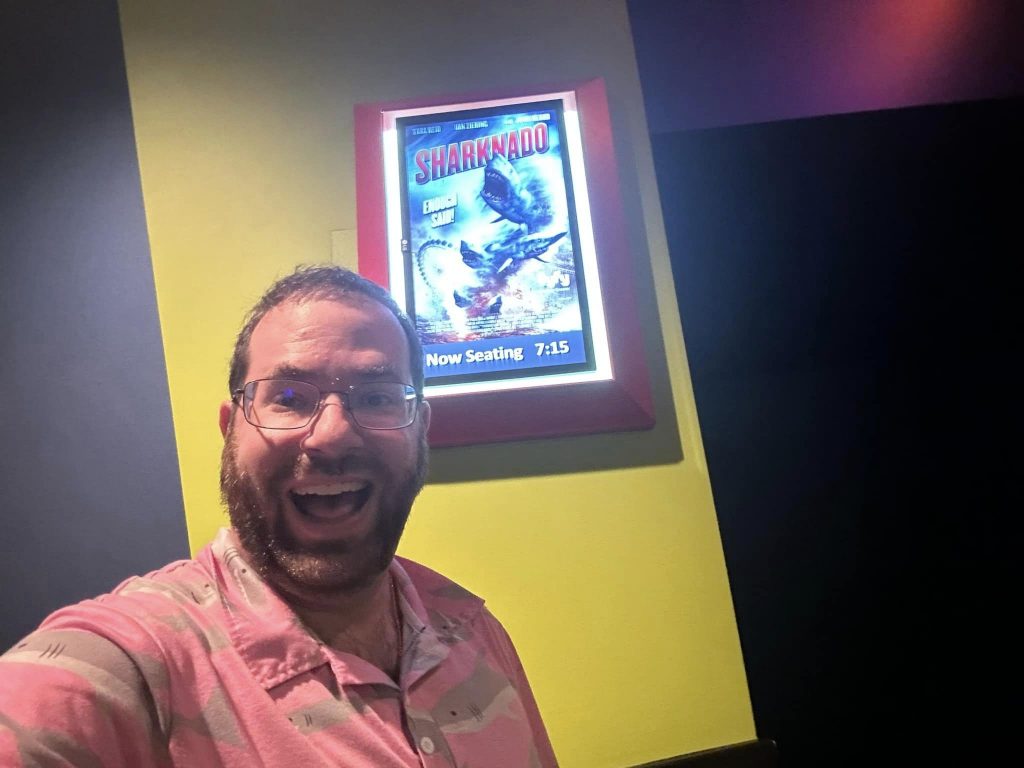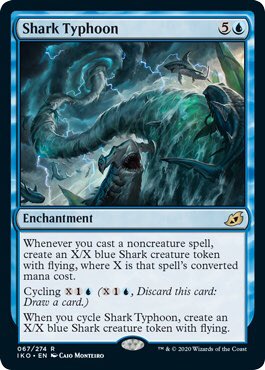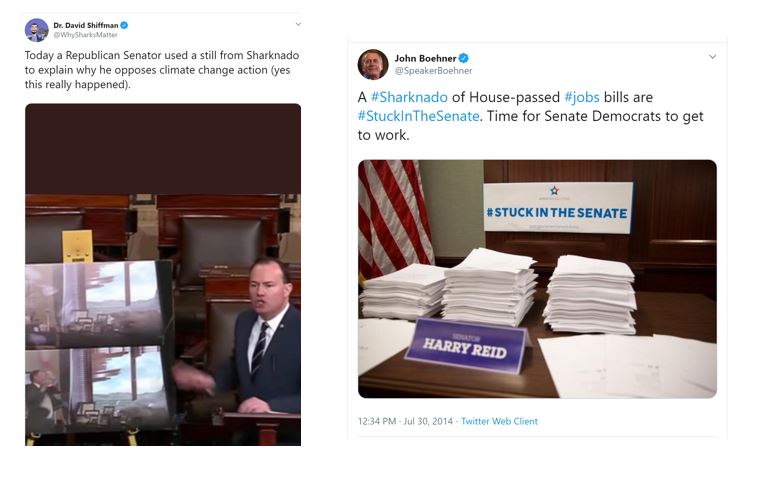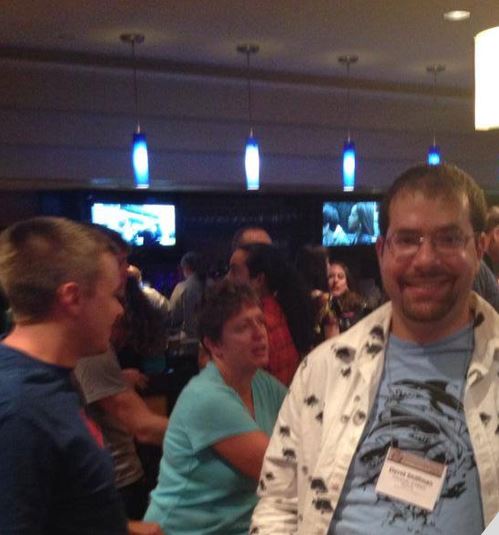Summer 2023 marks an important cultural milestone. That’s right, it has now been ten years since the release of SharkNado, which became a full-blown franchise with six movies, tens of millions in ad revenue and merchandise sales, real-world references in the floor of Congress, and near-universal awareness- all things that are otherwise unheard of for made-for-tv SyFy channel movies.
Me attending the tenth anniversary theaterical re-release, August 2023
“It’s been incredible gift to be able to share something this fun and silly with so many people over all this time,” Thunder Levin, the writer of the SharkNado franchise, told me in an interview. “It’s been extraordinary how many different people seem to have embraced it. I get to interact with fans who come from all walks of life, I even get to argue with shark scientists!”
SharkNado has always had it’s thumb on the pulse of pop culture
The Bad Shark Movies genre is rich and storied, but none of the others have had anywhere near the cultural impact or legacy of SharkNado. I’d like to try and explain what made the SharkNado movies special, and explore what that means for cinema, for sharks, and for me.
A staggering cultural impact that no one expected
As Forbes reported in 2014, “Campy creature features have always been around, but Sharknado has transcended that niche audience and become a global phenomenon.”
The AV Club noted that “No one affiliated with this franchise ever expected it to become a franchise, to take that SyFy/Asylum combination of bad acting, writing, and CGI and strike social-media gold. It shouldn’t have gotten one sequel and it got five of them.” (Heck, the overwhelming majority of these movies don’t get reviewed or reported on in Forbes, the Washington Post, Hollywood Reporter, and the AV club at all.)
An Oral History of the SharkNado franchise, which may be my all-time favorite piece of pop culture writing, noted that “The SyFy channel had a faithful niche audience of campy Saturday night movie enthusiasts, but none of the SyFy productions had punctured the pop culture bubble. When SharkNado touched down, it quickly entered the cultural zeitgeist as a full blown phenomenon.”
Archie comics had a special SharkNado issue, and there are real-world books. How Stuff Works wrote about the physics behind real-world storms that dumped fish far inland. It’s mentioned in Deadpool 2 and a Final Fantasy game, and there’s a Funko Pop and several halloween costumes and a Magic: the Gathering Card. I cannot stress enough that this Just Does Not Happen for most movies in this genre.
Obviously I have a deck built around this. It’s not important how often I win.
Part of the reason why it became a phenomenon was social media, where the premiere earned more than twice as many Twitter mentions as the infamous “Red Wedding” episode of Game of Thrones and was tweeted about by a variety of celebrities and journalists. Kaitlyn McNab called it “the first great movie of Twitter,” noting:
“Full disclosure: I did not watch this movie when it first aired on Syfy. Mostly because I don’t have cable, but also because I knew I would hate it. I hate a cheap, obvious sharksploitation movie, and sharks flying around in a tornado is pretty much the definition of it. So I didn’t watch it.Then the excitement rolled in and I was like “ya, whatever.” Then the critical praise rolled in and I was like “this is fucking horse shit.” So I watched it, multiple times… And that is why twitter can be so powerful. It can bring us together in a world fracturing apart. And it’s ultimately why something as terrible as Sharknado (guys. it is a terrible movie.) could make such a huge, substantial impact. Those who didn’t get it, didn’t tweet while watching and were thus confused (me). Those who got it, were tweeting about it and created a fun event that night that went down in history (a lot of people). And that’s pretty incredible. The first of its kind, making Sharknado the first, real movie of twitter.”
The premise of SharkNado was so silly that lead actor Ian Ziering famously didn’t even tell his family that he was going to be in it and that they should watch. No one expected anything like this. “When I was writing the movie, I was having fun, and I thought I’d be lucky if ten other people shared my sense of humor,” Thunder Levin told me. “I expected it might become a little cult film with a small deeply disturbed but devoted fan base, but we never expected how it took off and blew up and kept going. Our reception at ComicCon had a line out the door for a poster signing. We were blown away and acted like giddy schoolkids.”
The first movie was so popular that an ever-growing list of celebrities, from Neil DeGrasse Tyson to George R R Martin, from Penn and Teller to Frankie Muniz wanted to cameo.
Amazingly, the impact went beyond Hollywood and Twitter and into the halls of power.
In fact, shortly after a heated casting dispute in which he was told that Mark Cuban would be the President in SharkNado 3: Oh Hell No, but the role of Vice President was still available, Donald J Trump announced that he was running for President in real life. (I’m not saying that a SyFy channel movie had the power to save the world from the Trump years, but honestly, would anything about Trump’s decision-making surprise you at this point?)
The epic origin story
So who came up with this idea? A meme from 2015 stated “Next time you’re afraid to share your ideas, remember that someone once said in a meeting ‘let’s make a film with a tornado full of sharks.” But remarkably, the process wasn’t even that formal.
SharkNado was a SyFy original movie, part of the “Booming B-Movie Factory” that Bloomberg called “cheap, stupid, and enormously successful.” In the Before Times before streaming, cable channels had to solicit the creation of original films because otherwise there just wasn’t enough content. But they didn’t have the budgets to make original films that were, for lack of a better word, good.
The ”ridiculous origin story” idea for SharkNado specifically came from a throwaway line in another SyFy Channel original, “Leprechaun’s Revenge” (which some purists prefer to call “Red Clover.”) As Thunder Levin told Vice,
“I did not come up with the word “Sharknado.” That was actually mentioned in [Red Clover]. There was just a throwaway line of dialogue: There’s this town in the movie that’s, I guess, being besieged by leprechauns—I haven’t actually watched the whole thing. And somebody says,’Gosh, I hope we don’t go the way of that other town. They never recovered after the sharknado hit.’ One of the execs at SyFy, that stuck with them and they thought, ‘Hey, we should make a movie called Sharknado!’ I had just written a film called Mutant Vampire Zombies from the ‘Hood! and so I guess they figured I could handle the lighter tone.”
Why were the SharkNado movies different?
There are lots of Bad Shark Movies, a genre that dates back to at least 1950’s “Killer Shark” with Roddy McDowall.
(To learn more about the genre, check out the documentary SharksPloitation, featuring extensive interviews with me). There’s “Shark Exorcist,” with the tagline “Satan has Jaws.” There’s “Snow Sharks,” with the tagline “snow is just frozen water.” There’s “SharkTopus” (which eventually fights a half pterodactyl half barracuda,) and “five headed shark attack,” which are pretty self explanatory from the name. And let’s not forget “Sky Sharks,” in which Nazi Zombies use flying zombie sharks to try and take over the world. In the higher budget (but still bad) tier, you have “the Meg,” “47 meters down,” and Deep Blue Sea.” But none of them have had anywhere near the impact of the SharkNado franchise, despite many having much bigger budgets and bigger stars. Why? What is different about SharkNado?
“The big thing that sets us apart is that we were able to walk a very fine line between outright satire and straight disaster film,” Thunder Levin told me. “It was that balance, and the sense of fun that Sharknado exuded, is what made it catch on. And another of the things that made SharkNado take off when other films in a similar genre didn’t is the title- it’s just brilliant. It so clearly states what it is, and it sounds so ridiculous that was a certain curiosity about it.”
Levin has been consistent on this point for a decade. In a 2014 interview with the Hollywood Reporter, he said that:
“There have been a lot of these movies with crazy titles where they’ll either play it completely straight or play it obviously for laughs. Either way, it doesn’t quite take off, it doesn’t quite have that little wink. The characters in our movie were always grounded. They were never winking at the audience, but there was this sense of fun behind the whole thing. We’re going to do some ridiculous stuff and hopefully you’re going to enjoy the ride… There was a sense of responsibility in that we had to do justice to the characters, had to keep them consistent, but we also had to provide the fans with what they would be looking for. That was the guiding principle — making sure we didn’t go too far in the other direction and turn it into something slapstick, which it was never supposed to be and never was.”
There is indeed a sense of silly fun, without being slapstick, that permeates these movies. They never take themselves too seriously- they never try to explain the reasons for the SharkNados beyond “climate change,” but it’s not a slapstick comedy. There was a very stupid debate a few years ago about whether Marvel superhero movies are “films” or “movies,” and while I think most would agree that SharkNado isn’t high art, unlike many other SyFy original movies, it’s very watchable, even re-watchable.
Thunder Levin told me that he has just one regret: that the beyond-anyone’s-wildest-dreams success of SharkNado hasn’t led to a larger scale revival of gonzo filmmaking. “Despite SharkNado’s success and things like Cocaine Bear, and the historical popularity of things like Buckaroo Bonzai (which I always cite as being a spiritual guide to SharkNado), studios haven’t embraced ridiculous, over the top, pure fun movies that don’t take themselves seriously,” Levin told me. “And I wish they would, if only for my own sake.”
(Levin then proceeded to tell me about a pitch he’s been trying to find a home for called DeadBeard, which he described as a zombie pirate musical. Shut up and take my money).
Finally, a thing that I loved (while few people probably even noticed) is that while realism was obviously not the goal of these movies, the team had a commitment to sneaking in real science as a wink to their surprisingly large fan base in the scientific community. More than 50 species of sharks are featured across the franchise. Eagle -eyed viewers might have noted that in SharkNado 3 Oh Hell No, they describe as-yet-unpublished but soon to be highly publicized scientific research…because one of the producers saw me tweet about a conference talk. And- I’m just gonna throw it out there- the hurricane that causes the original SharkNado is called Hurricane David.
SharkNado and me
I love the Bad Shark Movies genre and have seen them all. (Chainsaw to my head, I’d have to say that my favorite is “mega shark vs. giant octopus.) But the SharkNado franchise will always have a special place in my heart.
In 2014, SharkNado 2: The Second One* aired with unfortunate timing- I was going to be out of town attending a conference. But, being the dweezle nerd that I am, I had an idea. I called a sports bar across the street from the conference center and asked to speak with the manager for what I promised would be the most ridiculous question he’d ever received. Amazingly, the Chattanooga, Tennessee sports bar manager had heard of SharkNado, and agreed not only to show it on all his TVs with the sound on, but not to charge me anything for this as long as he could advertise to his regulars that they could watch SharkNado with hundreds of marine biologists. This is still one of my all-time favorite evenings.
And, as longtime social media followers know, SharkNado 2 is thanked in my Ph.D. Dissertation, because they funded one of my research chapters.
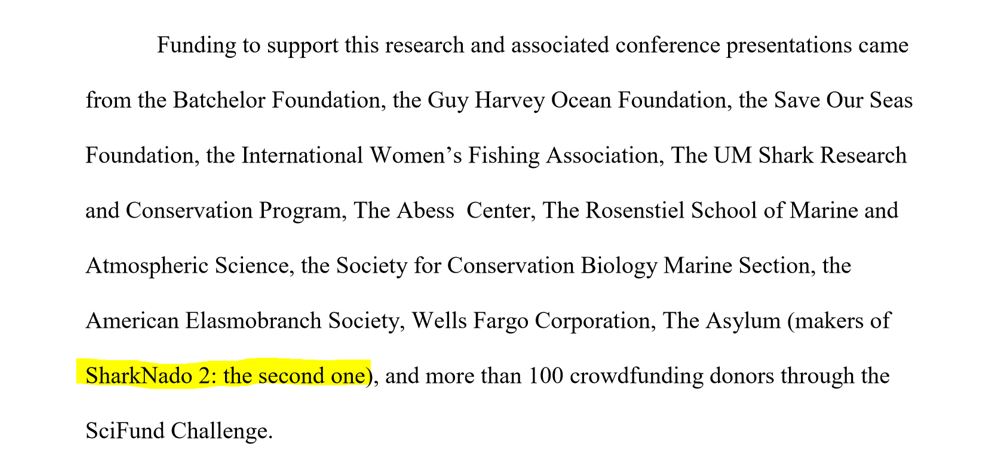
*I’m still a little upset that they rejected my suggestion of “SharkNado Harder as the subtitle but I’ll get over it by the time of the 20th anniversary)
What does this say about sharks?
The movie Jaws is widely perceived as contributing to the real-world persecution of sharks. It terrified a whole generation around the world who otherwise hadn’t really thought about sharks very much. Jaws has changed not only public perception of sharks, but the real-world ocean policy landscape- we even have something called the “Jaws Effect” to describe how fictional portrayal of real world issues impacts real world policy preferences from the public. And, as further evidence that the entire universe’s purpose is to torment me specifically, you may recall that in the height of the pandemic, former British Prime Minister Boris Johnson stated that his personal political hero was the mayor from Jaws who didn’t shut down the beaches after a series of shark bites.
So do Bad Shark Movies like SharkNado contribute to ocean conservation crises in the same way as Jaws? I haven’t seen any evidence either way, but I don’t believe they do. Jaws isn’t realistic at all, that’s not how white sharks behave, but it feels realistic in a way that “Six Headed Shark Attack” doesn’t. I think these movies are harmless escapist silly fun.
But what they do mean is that sharks are a big part of pop culture, which, as an interdisciplinary scientist who studies public perception of sharks, is fascinating and wonderful.
What’s next?
As with “superhero fatigue,” there’s always a chance that the Bad Shark Movie bubble will burst. We’ve had two-headed shark attack, three-headed shark attack, five-headed shark attack, and six-headed shark attack- what’s next? Seven-headed shark attack? That’d obviously be far too unrealistic.
But maybe we should embrace the spirit of SharkNado and not take ourselves too seriously here. Maybe we shouldn’t think too hard about this, and should just sit back, and enjoy the delightfully silly ride.

